University of Sunderland: Human Trafficking Case Study Report
VerifiedAdded on 2022/09/21
|5
|1214
|53
Report
AI Summary
This report provides a descriptive analysis of human trafficking, defining it as the trade of humans for exploitation. It explores the causes, such as poverty, illiteracy, and immigration policies, highlighting the role of traffickers who prey on vulnerable individuals. The report examines the severe consequences of human trafficking, including physical, mental, and economic impacts on victims and communities. It also delves into feminist perspectives, such as the third wave of feminism, which views sex trafficking as a result of patriarchy. Furthermore, it includes a humanist approach that emphasizes the dehumanization and violence faced by victims. The report references global statistics on poverty and emphasizes the ongoing efforts of the United Nations to combat human trafficking, concluding that the issue is a grave concern requiring global attention and action. The report includes references to various sources that support the findings and analysis.
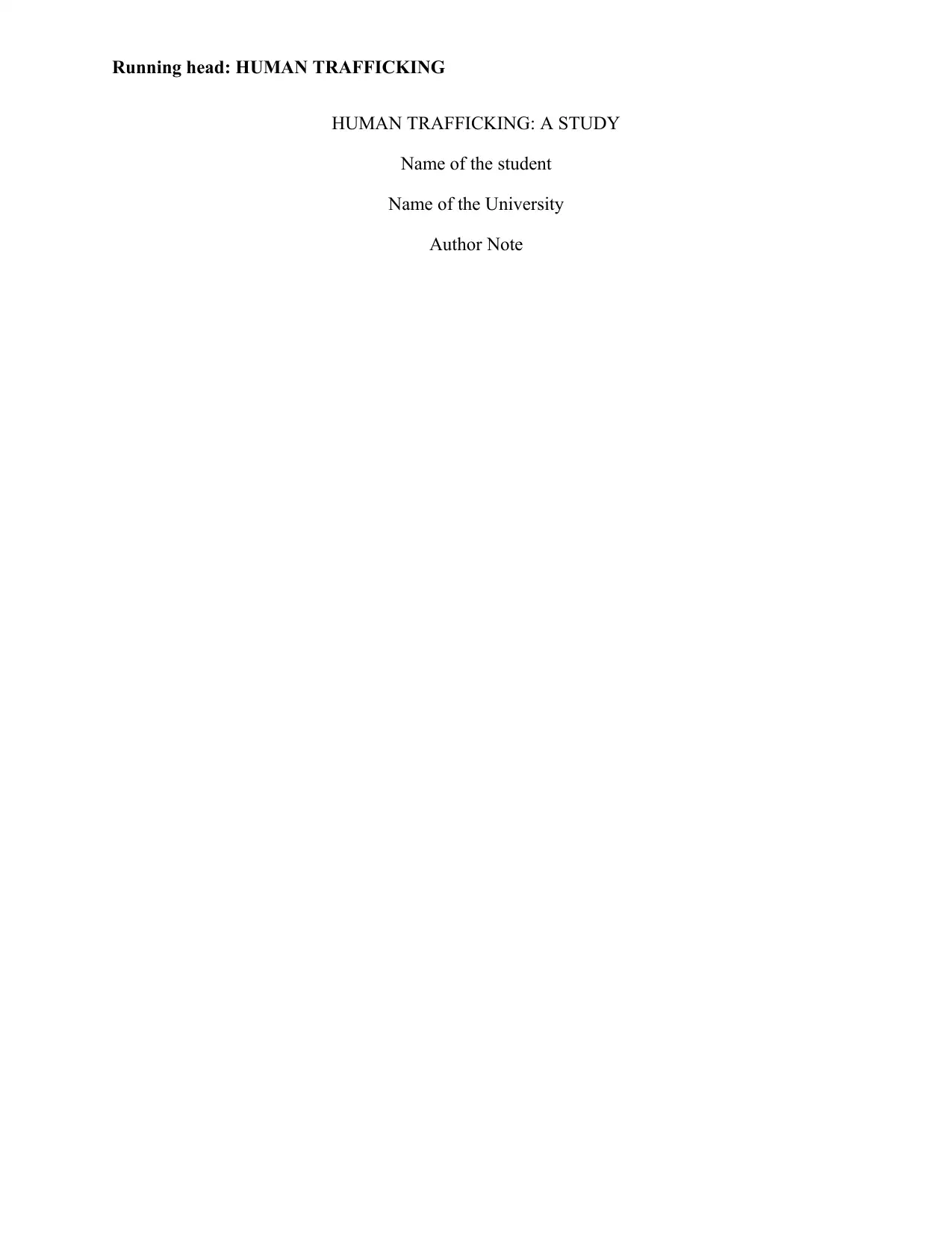
Running head: HUMAN TRAFFICKING
HUMAN TRAFFICKING: A STUDY
Name of the student
Name of the University
Author Note
HUMAN TRAFFICKING: A STUDY
Name of the student
Name of the University
Author Note
Paraphrase This Document
Need a fresh take? Get an instant paraphrase of this document with our AI Paraphraser
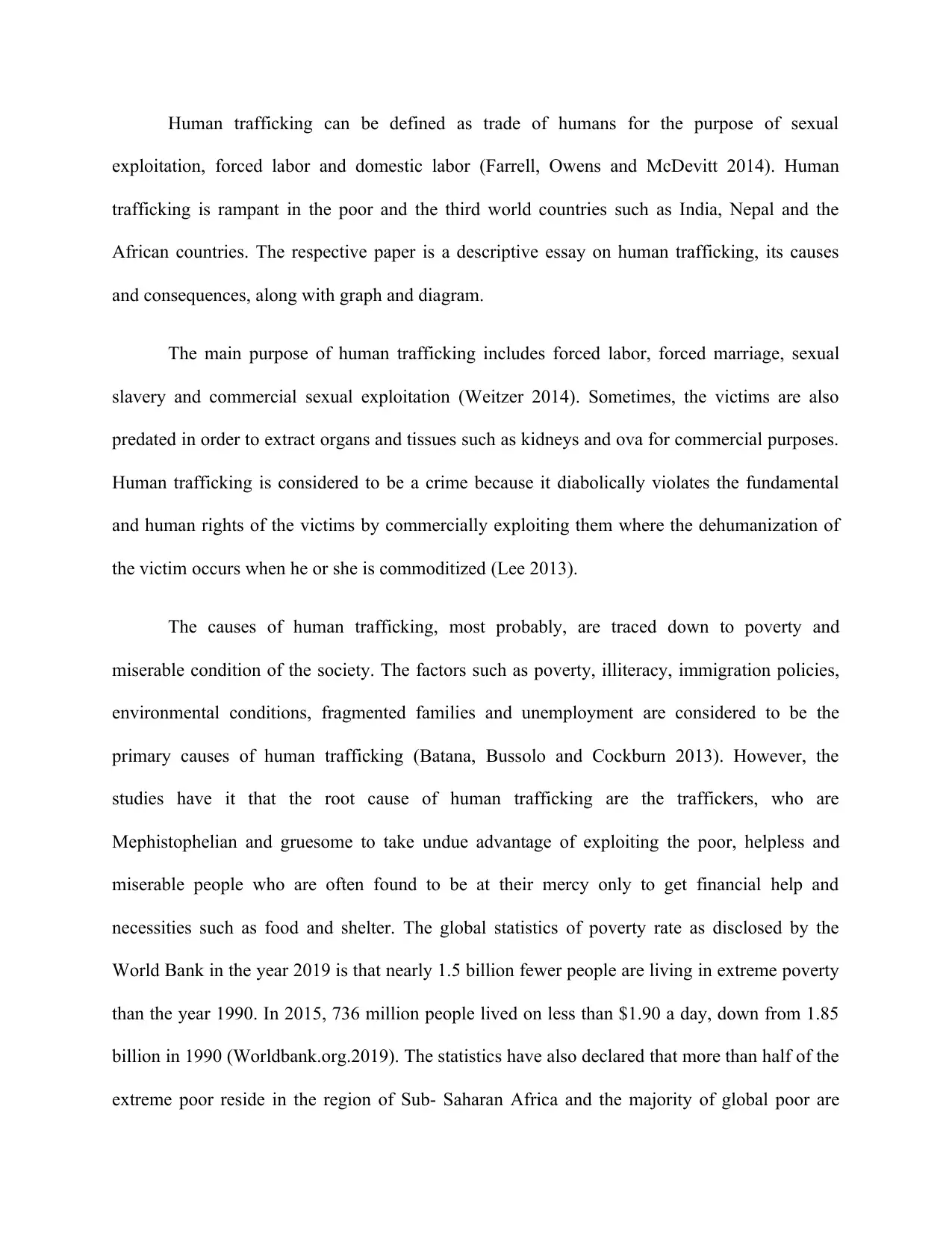
Human trafficking can be defined as trade of humans for the purpose of sexual
exploitation, forced labor and domestic labor (Farrell, Owens and McDevitt 2014). Human
trafficking is rampant in the poor and the third world countries such as India, Nepal and the
African countries. The respective paper is a descriptive essay on human trafficking, its causes
and consequences, along with graph and diagram.
The main purpose of human trafficking includes forced labor, forced marriage, sexual
slavery and commercial sexual exploitation (Weitzer 2014). Sometimes, the victims are also
predated in order to extract organs and tissues such as kidneys and ova for commercial purposes.
Human trafficking is considered to be a crime because it diabolically violates the fundamental
and human rights of the victims by commercially exploiting them where the dehumanization of
the victim occurs when he or she is commoditized (Lee 2013).
The causes of human trafficking, most probably, are traced down to poverty and
miserable condition of the society. The factors such as poverty, illiteracy, immigration policies,
environmental conditions, fragmented families and unemployment are considered to be the
primary causes of human trafficking (Batana, Bussolo and Cockburn 2013). However, the
studies have it that the root cause of human trafficking are the traffickers, who are
Mephistophelian and gruesome to take undue advantage of exploiting the poor, helpless and
miserable people who are often found to be at their mercy only to get financial help and
necessities such as food and shelter. The global statistics of poverty rate as disclosed by the
World Bank in the year 2019 is that nearly 1.5 billion fewer people are living in extreme poverty
than the year 1990. In 2015, 736 million people lived on less than $1.90 a day, down from 1.85
billion in 1990 (Worldbank.org.2019). The statistics have also declared that more than half of the
extreme poor reside in the region of Sub- Saharan Africa and the majority of global poor are
exploitation, forced labor and domestic labor (Farrell, Owens and McDevitt 2014). Human
trafficking is rampant in the poor and the third world countries such as India, Nepal and the
African countries. The respective paper is a descriptive essay on human trafficking, its causes
and consequences, along with graph and diagram.
The main purpose of human trafficking includes forced labor, forced marriage, sexual
slavery and commercial sexual exploitation (Weitzer 2014). Sometimes, the victims are also
predated in order to extract organs and tissues such as kidneys and ova for commercial purposes.
Human trafficking is considered to be a crime because it diabolically violates the fundamental
and human rights of the victims by commercially exploiting them where the dehumanization of
the victim occurs when he or she is commoditized (Lee 2013).
The causes of human trafficking, most probably, are traced down to poverty and
miserable condition of the society. The factors such as poverty, illiteracy, immigration policies,
environmental conditions, fragmented families and unemployment are considered to be the
primary causes of human trafficking (Batana, Bussolo and Cockburn 2013). However, the
studies have it that the root cause of human trafficking are the traffickers, who are
Mephistophelian and gruesome to take undue advantage of exploiting the poor, helpless and
miserable people who are often found to be at their mercy only to get financial help and
necessities such as food and shelter. The global statistics of poverty rate as disclosed by the
World Bank in the year 2019 is that nearly 1.5 billion fewer people are living in extreme poverty
than the year 1990. In 2015, 736 million people lived on less than $1.90 a day, down from 1.85
billion in 1990 (Worldbank.org.2019). The statistics have also declared that more than half of the
extreme poor reside in the region of Sub- Saharan Africa and the majority of global poor are
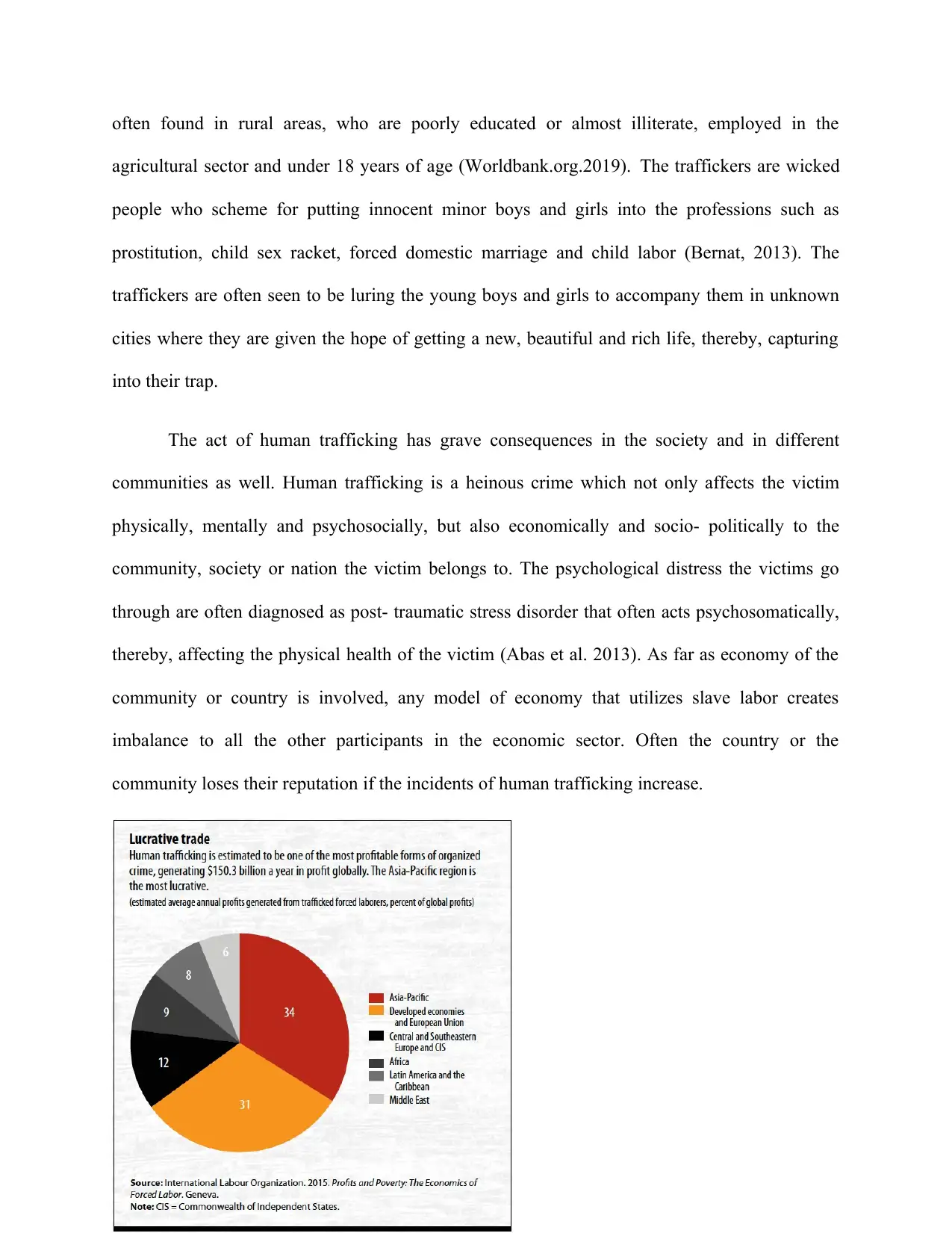
often found in rural areas, who are poorly educated or almost illiterate, employed in the
agricultural sector and under 18 years of age (Worldbank.org.2019). The traffickers are wicked
people who scheme for putting innocent minor boys and girls into the professions such as
prostitution, child sex racket, forced domestic marriage and child labor (Bernat, 2013). The
traffickers are often seen to be luring the young boys and girls to accompany them in unknown
cities where they are given the hope of getting a new, beautiful and rich life, thereby, capturing
into their trap.
The act of human trafficking has grave consequences in the society and in different
communities as well. Human trafficking is a heinous crime which not only affects the victim
physically, mentally and psychosocially, but also economically and socio- politically to the
community, society or nation the victim belongs to. The psychological distress the victims go
through are often diagnosed as post- traumatic stress disorder that often acts psychosomatically,
thereby, affecting the physical health of the victim (Abas et al. 2013). As far as economy of the
community or country is involved, any model of economy that utilizes slave labor creates
imbalance to all the other participants in the economic sector. Often the country or the
community loses their reputation if the incidents of human trafficking increase.
agricultural sector and under 18 years of age (Worldbank.org.2019). The traffickers are wicked
people who scheme for putting innocent minor boys and girls into the professions such as
prostitution, child sex racket, forced domestic marriage and child labor (Bernat, 2013). The
traffickers are often seen to be luring the young boys and girls to accompany them in unknown
cities where they are given the hope of getting a new, beautiful and rich life, thereby, capturing
into their trap.
The act of human trafficking has grave consequences in the society and in different
communities as well. Human trafficking is a heinous crime which not only affects the victim
physically, mentally and psychosocially, but also economically and socio- politically to the
community, society or nation the victim belongs to. The psychological distress the victims go
through are often diagnosed as post- traumatic stress disorder that often acts psychosomatically,
thereby, affecting the physical health of the victim (Abas et al. 2013). As far as economy of the
community or country is involved, any model of economy that utilizes slave labor creates
imbalance to all the other participants in the economic sector. Often the country or the
community loses their reputation if the incidents of human trafficking increase.
⊘ This is a preview!⊘
Do you want full access?
Subscribe today to unlock all pages.

Trusted by 1+ million students worldwide
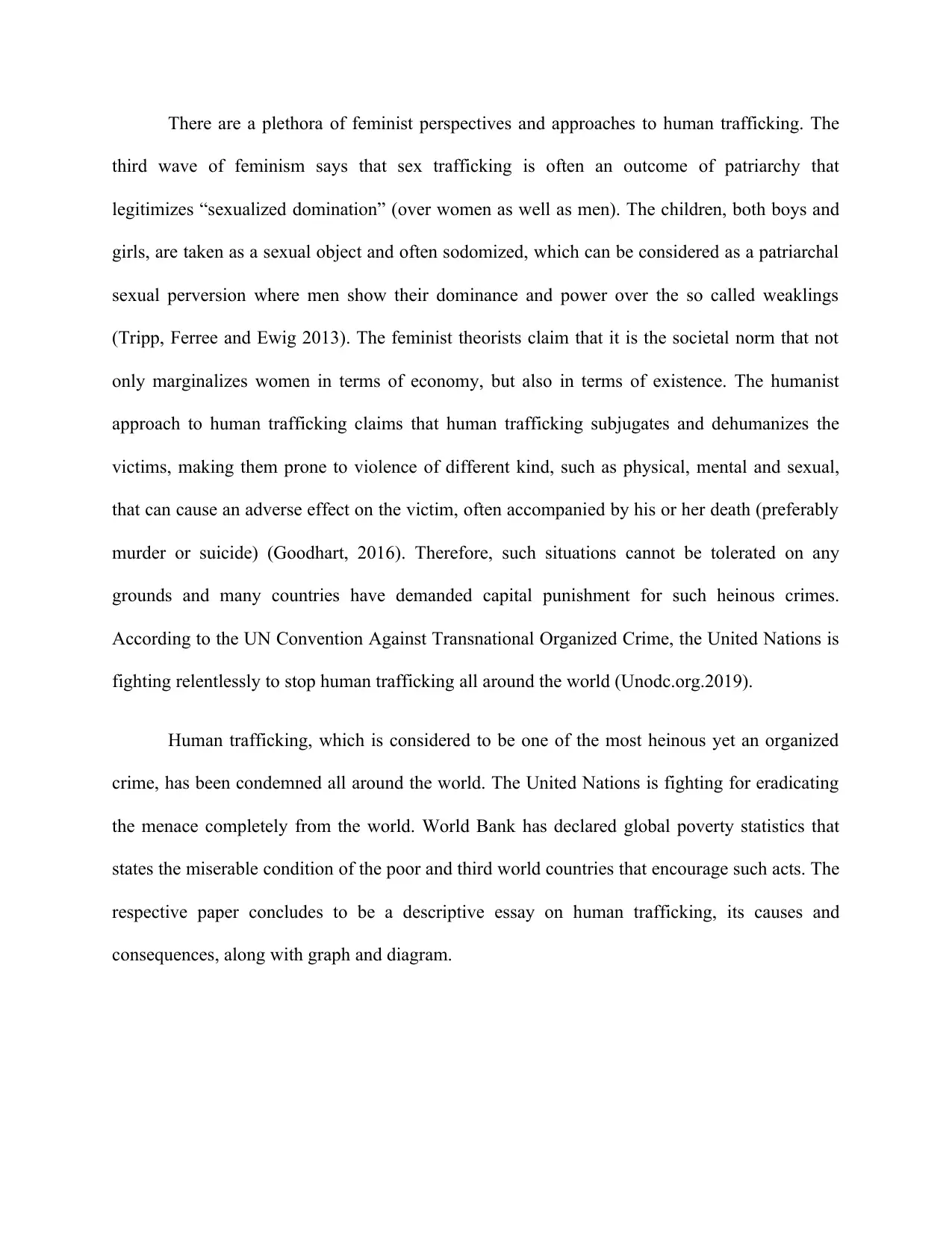
There are a plethora of feminist perspectives and approaches to human trafficking. The
third wave of feminism says that sex trafficking is often an outcome of patriarchy that
legitimizes “sexualized domination” (over women as well as men). The children, both boys and
girls, are taken as a sexual object and often sodomized, which can be considered as a patriarchal
sexual perversion where men show their dominance and power over the so called weaklings
(Tripp, Ferree and Ewig 2013). The feminist theorists claim that it is the societal norm that not
only marginalizes women in terms of economy, but also in terms of existence. The humanist
approach to human trafficking claims that human trafficking subjugates and dehumanizes the
victims, making them prone to violence of different kind, such as physical, mental and sexual,
that can cause an adverse effect on the victim, often accompanied by his or her death (preferably
murder or suicide) (Goodhart, 2016). Therefore, such situations cannot be tolerated on any
grounds and many countries have demanded capital punishment for such heinous crimes.
According to the UN Convention Against Transnational Organized Crime, the United Nations is
fighting relentlessly to stop human trafficking all around the world (Unodc.org.2019).
Human trafficking, which is considered to be one of the most heinous yet an organized
crime, has been condemned all around the world. The United Nations is fighting for eradicating
the menace completely from the world. World Bank has declared global poverty statistics that
states the miserable condition of the poor and third world countries that encourage such acts. The
respective paper concludes to be a descriptive essay on human trafficking, its causes and
consequences, along with graph and diagram.
third wave of feminism says that sex trafficking is often an outcome of patriarchy that
legitimizes “sexualized domination” (over women as well as men). The children, both boys and
girls, are taken as a sexual object and often sodomized, which can be considered as a patriarchal
sexual perversion where men show their dominance and power over the so called weaklings
(Tripp, Ferree and Ewig 2013). The feminist theorists claim that it is the societal norm that not
only marginalizes women in terms of economy, but also in terms of existence. The humanist
approach to human trafficking claims that human trafficking subjugates and dehumanizes the
victims, making them prone to violence of different kind, such as physical, mental and sexual,
that can cause an adverse effect on the victim, often accompanied by his or her death (preferably
murder or suicide) (Goodhart, 2016). Therefore, such situations cannot be tolerated on any
grounds and many countries have demanded capital punishment for such heinous crimes.
According to the UN Convention Against Transnational Organized Crime, the United Nations is
fighting relentlessly to stop human trafficking all around the world (Unodc.org.2019).
Human trafficking, which is considered to be one of the most heinous yet an organized
crime, has been condemned all around the world. The United Nations is fighting for eradicating
the menace completely from the world. World Bank has declared global poverty statistics that
states the miserable condition of the poor and third world countries that encourage such acts. The
respective paper concludes to be a descriptive essay on human trafficking, its causes and
consequences, along with graph and diagram.
Paraphrase This Document
Need a fresh take? Get an instant paraphrase of this document with our AI Paraphraser
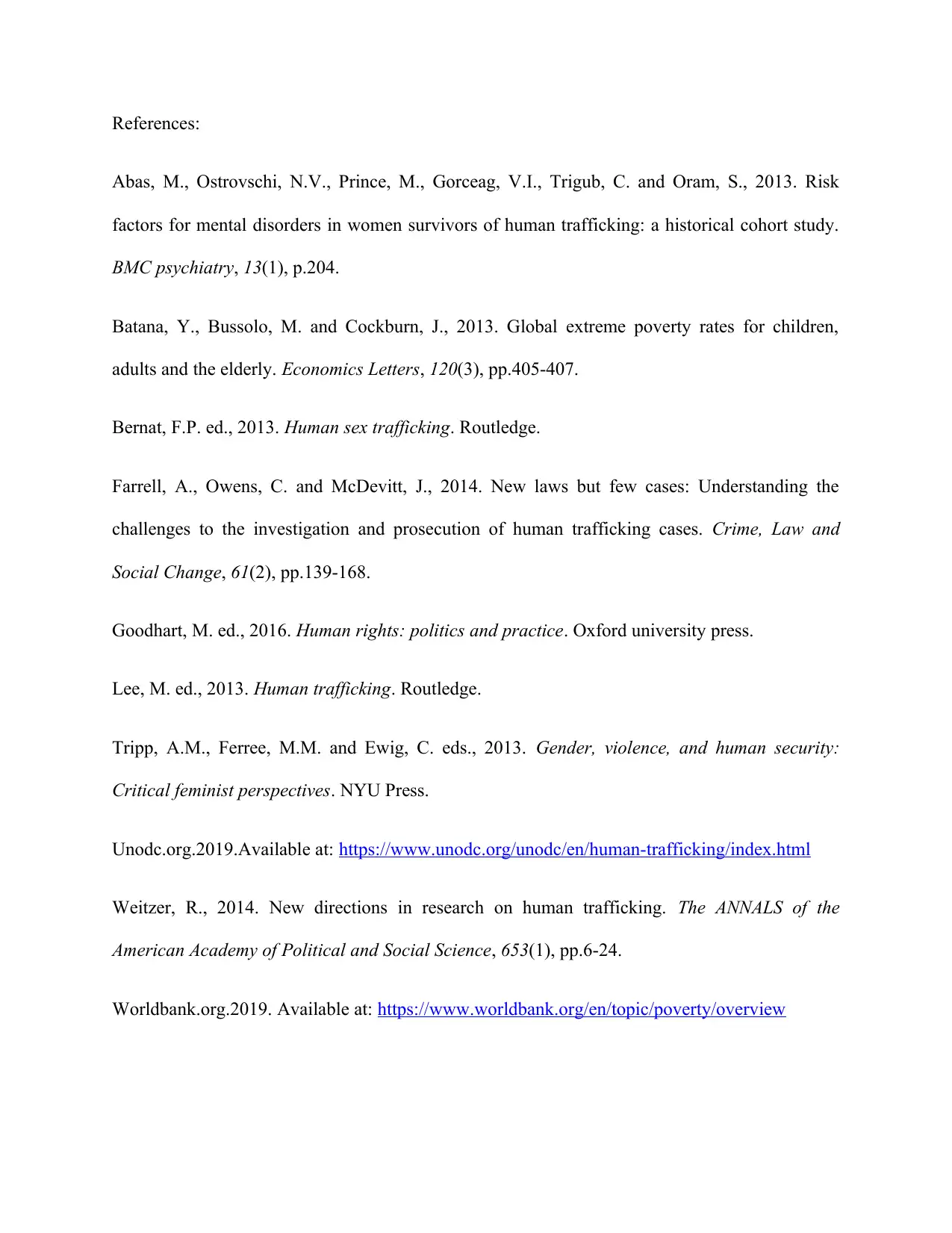
References:
Abas, M., Ostrovschi, N.V., Prince, M., Gorceag, V.I., Trigub, C. and Oram, S., 2013. Risk
factors for mental disorders in women survivors of human trafficking: a historical cohort study.
BMC psychiatry, 13(1), p.204.
Batana, Y., Bussolo, M. and Cockburn, J., 2013. Global extreme poverty rates for children,
adults and the elderly. Economics Letters, 120(3), pp.405-407.
Bernat, F.P. ed., 2013. Human sex trafficking. Routledge.
Farrell, A., Owens, C. and McDevitt, J., 2014. New laws but few cases: Understanding the
challenges to the investigation and prosecution of human trafficking cases. Crime, Law and
Social Change, 61(2), pp.139-168.
Goodhart, M. ed., 2016. Human rights: politics and practice. Oxford university press.
Lee, M. ed., 2013. Human trafficking. Routledge.
Tripp, A.M., Ferree, M.M. and Ewig, C. eds., 2013. Gender, violence, and human security:
Critical feminist perspectives. NYU Press.
Unodc.org.2019.Available at: https://www.unodc.org/unodc/en/human-trafficking/index.html
Weitzer, R., 2014. New directions in research on human trafficking. The ANNALS of the
American Academy of Political and Social Science, 653(1), pp.6-24.
Worldbank.org.2019. Available at: https://www.worldbank.org/en/topic/poverty/overview
Abas, M., Ostrovschi, N.V., Prince, M., Gorceag, V.I., Trigub, C. and Oram, S., 2013. Risk
factors for mental disorders in women survivors of human trafficking: a historical cohort study.
BMC psychiatry, 13(1), p.204.
Batana, Y., Bussolo, M. and Cockburn, J., 2013. Global extreme poverty rates for children,
adults and the elderly. Economics Letters, 120(3), pp.405-407.
Bernat, F.P. ed., 2013. Human sex trafficking. Routledge.
Farrell, A., Owens, C. and McDevitt, J., 2014. New laws but few cases: Understanding the
challenges to the investigation and prosecution of human trafficking cases. Crime, Law and
Social Change, 61(2), pp.139-168.
Goodhart, M. ed., 2016. Human rights: politics and practice. Oxford university press.
Lee, M. ed., 2013. Human trafficking. Routledge.
Tripp, A.M., Ferree, M.M. and Ewig, C. eds., 2013. Gender, violence, and human security:
Critical feminist perspectives. NYU Press.
Unodc.org.2019.Available at: https://www.unodc.org/unodc/en/human-trafficking/index.html
Weitzer, R., 2014. New directions in research on human trafficking. The ANNALS of the
American Academy of Political and Social Science, 653(1), pp.6-24.
Worldbank.org.2019. Available at: https://www.worldbank.org/en/topic/poverty/overview
1 out of 5
Related Documents
Your All-in-One AI-Powered Toolkit for Academic Success.
+13062052269
info@desklib.com
Available 24*7 on WhatsApp / Email
![[object Object]](/_next/static/media/star-bottom.7253800d.svg)
Unlock your academic potential
Copyright © 2020–2025 A2Z Services. All Rights Reserved. Developed and managed by ZUCOL.





